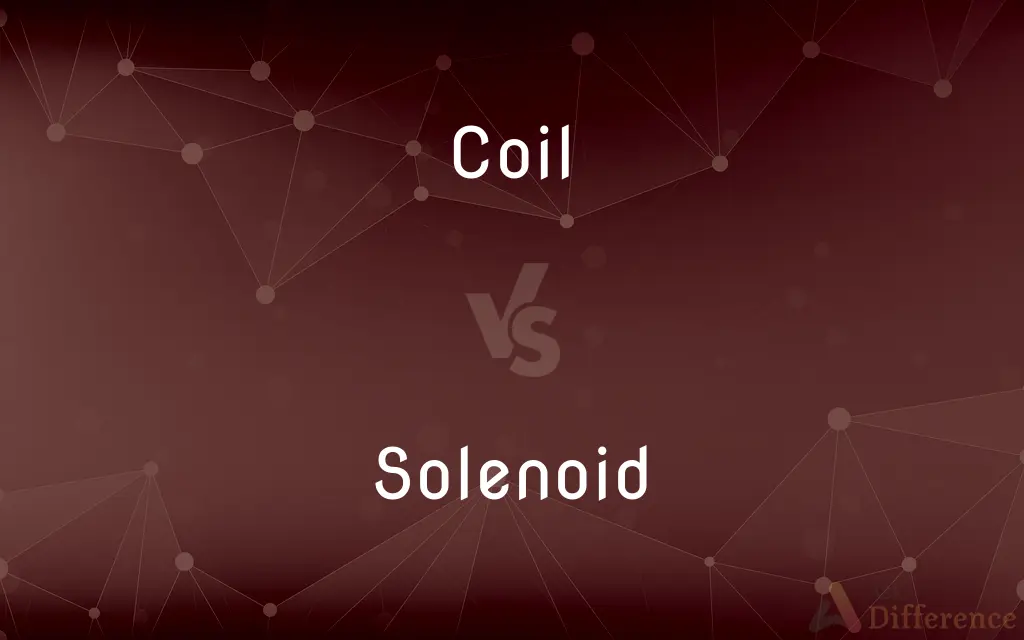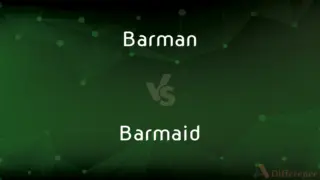Coil vs. Solenoid — What's the Difference?
Edited by Tayyaba Rehman — By Maham Liaqat — Updated on March 18, 2024
A coil is a series of loops, while a solenoid is a coil wound into a tightly packed helix.

Difference Between Coil and Solenoid
Table of Contents
ADVERTISEMENT
Key Differences
A coil refers broadly to any series of loops. While a solenoid specifically denotes a coil wound tightly into a helix, used to generate a magnetic field when electric current passes through it.
Coils can be found in various applications ranging from jewelry to electrical transformers, depending on their construction and material. Solenoids, on the other hand, are primarily used in electromagnetic devices, like relays and valves, highlighting their utility in converting electrical energy to mechanical action.
The shape and size of a coil can vary greatly, serving different functions in mechanical and electrical systems. Whereas solenoids typically have a cylindrical shape, optimizing the magnetic field generated within.
While coils can be passive components, simply used for storing energy or adding inductance to a circuit, solenoids act as active components, directly converting electrical energy into mechanical force.
In terms of energy transformation, coils in electrical circuits are primarily used for inductance, affecting the circuit's impedance. Solenoids transform electrical energy into linear motion, showcasing their difference in energy conversion.
ADVERTISEMENT
Comparison Chart
Definition
A series of loops
A coil wound into a helix
Primary Use
Varied, from jewelry to electrical transformers
Electromagnetic devices like relays and valves
Shape
Can vary
Typically cylindrical
Component Type
Passive or active depending on use
Active, converting electrical energy to mechanical force
Energy Transformation
Used for inductance in electrical circuits
Converts electrical energy into linear motion
Compare with Definitions
Coil
An electrical device designed to generate a magnetic field when current passes through it.
The engineer tested the coil for its electromagnetic properties.
Solenoid
An essential component in automotive starting systems.
Replacing a faulty solenoid fixed the car's starting problem.
Coil
A part of a vehicle's ignition system.
The mechanic replaced the faulty ignition coil to solve the starting issue.
Solenoid
A device converting electrical energy to mechanical action.
The door lock's solenoid activates to unlock the door when the correct code is entered.
Coil
An object that has been wound or gathered into loops.
He used a coil of rope to secure the boat to the dock.
Solenoid
A cylindrical coil of wire acting as a magnet when carrying electric current.
The solenoid was used to power the electromechanical relay.
Coil
To wind into a series of loops.
She coiled the garden hose neatly after watering the plants.
Solenoid
Part of an electromagnetic valve controlling fluid flow.
The irrigation system's efficiency was improved by installing solenoids in its valves.
Coil
A series of connected spirals or concentric rings formed by gathering or winding
A coil of rope.
Long coils of hair.
Solenoid
Used in physics experiments to demonstrate magnetic fields.
The students used a solenoid in their experiment to create a uniform magnetic field.
Coil
A spiral pipe or series of spiral pipes, as in a radiator.
Solenoid
A current-carrying coil of wire that acts like a magnet when a current passes through it.
Coil
A series of loops.
The jeweler crafted a beautiful necklace with a gold coil at its center.
Solenoid
A solenoid (,) is a type of electromagnet, the purpose of which is to generate a controlled magnetic field through a coil wound into a tightly packed helix. The coil can be arranged to produce a uniform magnetic field in a volume of space when an electric current is passed through it.
Coil
An individual spiral or ring within such a series.
Solenoid
An assembly used as a switch, consisting of a coil and a metal core free to slide along the coil axis under the influence of the magnetic field.
Coil
A wound spiral of two or more turns of insulated wire, used to introduce inductance into a circuit.
Solenoid
(physics) A coil of wire that acts as a magnet when an electric current flows through it.
Coil
Any of various devices of which such a spiral is the major component.
Solenoid
(engineering) An electromechanical device consisting of such a coil containing a metal core, the movement of which is controlled by the current.
Coil
A roll of postage stamps prepared for use in a vending machine.
Solenoid
(electronics) An electromechanical switch controlled by a solenoid; solenoid switch, relay.
Coil
A disturbance; a fuss.
Solenoid
(meteorology) The region of intersection between isobaric and isopycnal surfaces.
Coil
To wind in concentric rings or spirals.
Solenoid
An electrodynamic spiral having the conjuctive wire turned back along its axis, so as to neutralize that component of the effect of the current which is due to the length of the spiral, and reduce the whole effect to that of a series of equal and parallel circular currents. When traversed by a current the solenoid exhibits polarity and attraction or repulsion, like a magnet.
Coil
To wind into a shape resembling a coil.
Solenoid
A coil of wire around an iron core; becomes a magnet when current passes through the coil
Coil
To form concentric rings or spirals.
Coil
To move in a spiral course
Black smoke coiling up into the sky.
Coil
Something wound in the form of a helix or spiral.
The sinuous coils of a snake
Coil
Any intrauterine device (Abbreviation: IUD)—the first IUDs were coil-shaped.
Coil
(electronics) A coil of electrically conductive wire through which electricity can flow.
Coil
A cylinder of clay.
Coil
(figurative) Entanglement; perplexity.
Coil
A noise, tumult, bustle, or turmoil.
Coil
To wind or reel e.g. a wire or rope into regular rings, often around a centerpiece.
A simple transformer can be made by coiling two pieces of insulated copper wire around an iron heart.
Coil
To wind into loops (roughly) around a common center.
The sailor coiled the free end of the hawser on the pier.
Coil
To wind cylindrically or spirally.
To coil a rope when not in use
The snake coiled itself before springing.
Coil
To build a pot (etc) with clay coils.
Coil
To encircle and hold with, or as if with, coils.
Coil
To wind cylindrically or spirally; as, to coil a rope when not in use; the snake coiled itself before springing.
Coil
To encircle and hold with, or as with, coils.
Coil
To wind itself cylindrically or spirally; to form a coil; to wind; - often with about or around.
You can see his flery serpents . . . Coiting, playing in the water.
Coil
A ring, series of rings, or spiral, into which a rope, or other like thing, is wound.
The wild grapevines that twisted their coils from trec to tree.
Coil
Fig.: Entanglement; toil; mesh; perplexity.
Coil
A series of connected pipes in rows or layers, as in a steam heating apparatus.
Coil
A noise, tumult, bustle, or confusion.
Coil
A structure consisting of something wound in a continuous series of loops;
A coil of rope
Coil
A round shape formed by a series of concentric circles
Coil
A transformer that supplies high voltage to spark plugs in a gasoline engine
Coil
A contraceptive device placed inside a woman's womb
Coil
Tubing that is wound in a spiral
Coil
Reactor consisting of a spiral of insulated wire that introduces inductance into a circuit
Coil
To wind or move in a spiral course;
The muscles and nerves of his fine drawn body were coiling for action
Black smoke coiling up into the sky
The young people gyrated on the dance floor
Coil
Make without a potter's wheel;
This famous potter hand-builds all of her vessels
Coil
Wind around something in coils or loops
Common Curiosities
Can a solenoid be considered a type of coil?
Yes, a solenoid is a specific type of coil designed for generating a magnetic field in a specific manner.
What is a coil?
A coil is any series of loops, often used in electrical applications to generate magnetic fields or add inductance.
What makes a solenoid effective in converting electrical energy to mechanical action?
Its cylindrical shape and the way it's wound optimize the magnetic field generated, allowing for efficient conversion of energy.
Why are solenoids commonly used in valves and relays?
Because they can precisely control the movement of mechanical parts using electrical signals.
How do coils and solenoids differ in application?
Coils have a broad range of applications, from jewelry to electrical transformers, whereas solenoids are mainly found in electromagnetic devices.
Do coils and solenoids operate on the same principles?
They both operate on principles of electromagnetism, but solenoids apply these principles to create linear motion.
What is a solenoid?
A solenoid is a specific type of coil wound into a helix, used primarily to convert electrical energy into mechanical force.
How does the shape of a solenoid affect its function?
The cylindrical shape helps concentrate the magnetic field, enhancing its ability to convert electrical energy into motion.
How does the wire winding affect a coil's properties?
The number of turns, thickness, and material of the wire can affect a coil's inductance, resistance, and efficiency in magnetic field generation.
Are all coils capable of creating magnetic fields?
Yes, when electrical current passes through them, but the efficiency and purpose can vary widely.
Is it possible to use solenoids in everyday devices?
Yes, solenoids are used in many household devices, including doorbells, washing machines, and irrigation systems.
Can the term "coil" refer to non-electrical applications?
Yes, it can refer to any series of loops, not just those in electrical contexts.
Can solenoids produce rotational motion?
Typically, solenoids produce linear motion, but modifications and additional mechanisms can convert this into rotational motion.
What role do coils play in an electrical circuit?
They can add inductance, affecting the circuit's overall impedance and the way it responds to alternating current.
Can the function of a solenoid be reversed?
While solenoids are designed for converting electrical energy into mechanical action, reverse operation is not typically within their intended use.
Share Your Discovery

Previous Comparison
Creativity vs. Initiative
Next Comparison
Barman vs. BarmaidAuthor Spotlight
Written by
Maham LiaqatEdited by
Tayyaba RehmanTayyaba Rehman is a distinguished writer, currently serving as a primary contributor to askdifference.com. As a researcher in semantics and etymology, Tayyaba's passion for the complexity of languages and their distinctions has found a perfect home on the platform. Tayyaba delves into the intricacies of language, distinguishing between commonly confused words and phrases, thereby providing clarity for readers worldwide.














































